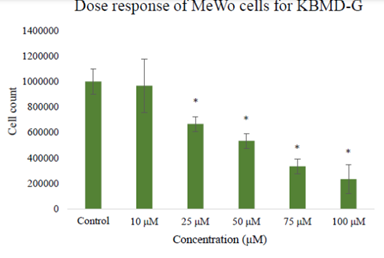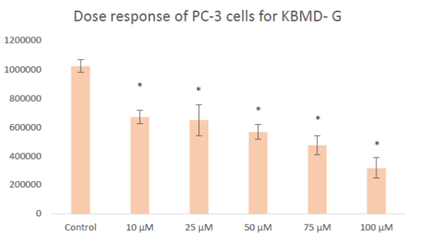Advantages:
- Precision Targeting: Selective cancer cell targeting minimizes harm to healthy tissues, enhancing safety.
- Preclinical Efficacy: Induces cancer cell apoptosis, showing promise for treating metastatic melanoma and prostate cancer.
- Scientific Rigor: Grounded in robust research, offering innovative oncology solutions.
Summary:
Metastatic melanoma and prostate cancer present significant challenges in the field of oncology, demanding innovative solutions. KBMD-E, KBMD-G, and KBMD-H, three small molecule compounds, have exhibited remarkable potential in preclinical studies. KBMD-E, has shown promise in treating metastatic melanoma by inducing apoptosis in aggressive cancer cells, leading to a substantial reduction in the populations of SK-MEL-2 and MeWo cells. Meanwhile, KBMD-G has demonstrated remarkable efficacy in combating metastatic prostate cancer. It significantly decreases the population of DU-145 and PC-3 cells, underscoring its ability to enhance apoptosis in prostate cancer cells. Similarly, KBMD-H has shown potential by significantly reducing the populations of DU-145 and PC-3 cells. These results indicate that these compounds hold promise for addressing unmet needs in the treatment of metastatic melanoma and prostate cancer.
Cytotoxicity studies have indicated that the compounds are well-tolerated by normal HEK-293 cells, with limited impact on their viability. These compounds effectively decrease cell proliferation in metastatic cancer cells, particularly in DU-145 and PC-3, without causing significant harm to normal cellular environments. The ability to selectively target cancer cells while preserving healthy ones positions these innovations as groundbreaking solutions in oncology, offering new hopes for patients facing these formidable cancers. These compounds could revolutionize the treatment landscape for metastatic melanoma and prostate cancer, providing new hope to patients confronting these formidable malignancies.


Figures 1 and 2 display dose-response graphs illustrating the impact of KBMD-G on MeWo (melanoma) and PC-3 (prostate) cells, respectively. These graphs demonstrate the relationship between cell count and KBMD-G concentration, providing a clear representation of the compound's effects on these specific cell lines.
Desired Partnerships:
- License
- Sponsored Research
- Co-Development